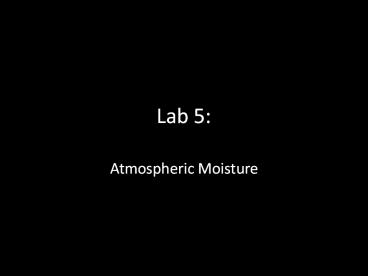Lab 5: - PowerPoint PPT Presentation
Title:
Lab 5:
Description:
Lab 5: Atmospheric Moisture Relative Humidity Sling Psychrometers: measures Relative Humidity Dry bulb temp Web bulb temp DB WB = Wet bulb depression DB vs. WB ... – PowerPoint PPT presentation
Number of Views:66
Avg rating:3.0/5.0
Title: Lab 5:
1
Lab 5
- Atmospheric Moisture
2
Relative Humidity
- Sling Psychrometers measures Relative Humidity
- Dry bulb temp
- Web bulb temp
DB WB Wet bulb depression
DB vs. WB Big difference dry air Small
difference moist air
3
Relative Humidity
- Swing for 60 seconds
- If you have a fraction, change to a whole number
- Record DB WB temps
- Individuals or groups
- 4 locations
- Inside Outside
4
Measuring Relative Humidity
Dry Bulb Temp Saturation Mixing Ratio (SMR) Wet Bulb Temp Wet-Bulb Depression Relative Humidity (RH) Mixing Ratio (MR)
Based on DB temp TABLE 2 DB WB Based on DB temp WBD TABLE 4 SMR RH (RH is a !)
5
Atmospheric Moisture Latent Heat
- Water comes in three phases
- Solid
- Liquid
- Vapor
- Unique to this atmospheric component
- Latent heat transfer process of water changing
phase - Energy is consumed or released
- Sensible heat heat we can feel measure
- Latent heat energy in the form of heat
- Sensible heat potential energy in the form of
thermal energy or heat - Latent heat amount of energy in the form of heat
released or absorbed by a chemical substance
during a change of state. - Kelvin is the most reliable measurement of
temperature because zero kelvin represents the
temperature at which all molecular motion stops.
6
- Heat average kinetic energy of a given amount of
liquid - Condensation warming process
- Evaporation cooling process
7
Atmospheric Moisture Latent Heat
Phase change Energy Examples
Ice ? (liquid) water Consumed Ice cubes melting in a glass melting of falling snowflake
Water ? water vapor Consumed Clothes drying evaporation off a water surface
Ice ? water vapor Consumed Solid air freshner sublimation of snow/ice
Water vapor ? water Released Dew condensation on a cold can of pop contrail
Water vapor ? ice Released Frost on grass or on a window
Water ? ice Released Freezing ice cubes
8
- Amount of water vapor in the air depends on
amount of energy available to change liquid ?
gas. - As temperature increases, the liquid water
molecules start moving fasterits more likely to
evaporate - Energy NOT used to boil the water is used to
change the state of the water from liquid to gas
9
- Two ways to measure atmospheric moisture
- Vapor pressure
- Water vapor molecules exert pressure proportional
to their concentration in the atmosphere - Maximum is called saturation vapor pressure
- SVP increases with temperature
10
- 2. Mixing Ratio
- Mass of water vapor in the air
- Ratio of water vapor mass to the mass of dry air
- Units of grams of water vapor per kilogram of dry
air - saturation mixing ratio air is saturated
- Depends on temperature (? with temperature)
- Represents max weight of water vapor/kilogram of
dry air
11
- Relative Humidity measures how close the air
sample is to saturation - It is a ratio of actual water vapor in the air to
the saturation level at a given temperature. - The greater the difference between air
temperature the dew point, the lower the RH
(dry air) - RH is temperature dependant
12
(No Transcript)
13
Winter?
- Warming up already dry air will DECREASE Relative
Humidity! - Does winter indicate air that would be dry or
moist? In the winter, air is generally rather
dry. Cold air has less capacity to hold water
vapor than warm air. - Heat in your home becomes dry
14
(No Transcript)
15
Summer?
- In the summer, air is generally moist. Warm air
can hold greater amounts of water vapor than cold
air. - Cooling already moist air will INCREASE Relative
Humidity!
16
Dew Point
- Dew point temperature to which air must be
cooled to reach saturation (RH 100) - Generally seen as dew in the morning on the
grass.
17
Dew Point
- Find MR of 17
- Create a STRAIGHT line to the dew point line
- Create another STRAIGHT line down to the
temperature - Read the temperature.
A 30 air sample would have to cool to 22 to
reach saturation (100 humidity)































